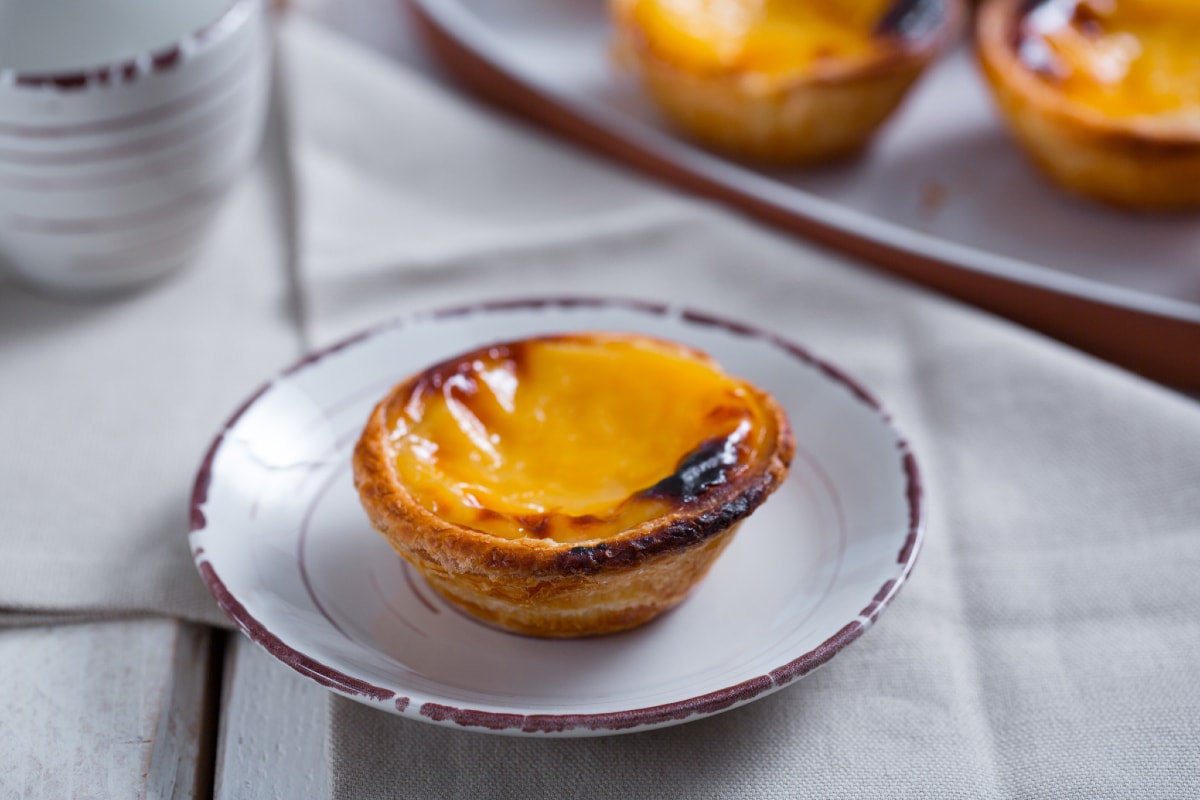Pasteis de nata

- Vegetarian
- Difficulty: Average
- Prep time: 1 h 10 min
- Cook time: 40 min
- Makes: 20 pieces
- Cost: Low
- Note + chilling time in the refrigerator (about 1 h total)
PRESENTATION
Pastéis de nata are these golden, crispy little pastries that folks in Portugal are super proud of, especially in the Belém area of Lisbon. I mean, really proud. People say the first ones showed up back in the 1800s, right near an old monastery, and ever since, they’ve kinda become a symbol of Portuguese baking. The thing is, what makes them different is that awesome mix of a flaky, crunchy shell and a warm, tender custard center that’s sweet but not too heavy. You know, a bit like crème brûlée or crema catalana, but these Portuguese custard tarts definitely have their own vibe.
First bite? Crispy on the outside, then moist and silky in the middle—seriously good. Whenever you see someone enjoying a coffee in Lisbon, you’ll probably spot one of these next to their cup. The contrast of the pastry and the creamy filling is what everyone talks about, and, honestly, it’s a flavor that sticks with you.
And here's the deal, these treats fit into the bigger world of traditional Portuguese desserts. Alongside stuff like Bacalhau a Braz and Azevias, pastéis de nata hold a special spot on dessert tables and in bakery windows all over the country. And listen, people really love to chat about how to make pastéis de nata. Every bakery seems to have its own spin on the classic recipe. Some go for extra golden tops, others keep the custard extra silky. So, so silky.
There’s a real pride in the way they’re made—using simple ingredients that taste way fancier than you’d expect. And look, even if you’re into baking at home, the pastéis de nata recipe is one a lot of people try when they’re craving a little taste of Portugal.
Pairing them with coffee? It’s a big deal. It’s not just about the sweet treat, it’s the whole experience of relaxing and soaking up a piece of Lisbon, wherever you are. So, when you get a chance to try these puff pastry custard tarts, you’re tasting something real with a lot of history and heart behind every bite. For sure.
You might also like:
INGREDIENTS
- For the puff pastry (for 20 pasteis)
- Type 00 flour 2 cups (250 g)
- Vegetable margarine 6.2 oz (175 g)
- Water 0.625 cup (150 g) - at room temperature
- Fine salt 1 pinch
- For the cream
- Whole milk 2.1 cups (500 g)
- Sugar 2 ½ cups (500 g)
- Water 1.1 cups (250 g)
- Type 00 flour ½ cup (64 g)
- Cornstarch 4 tsp (10 g)
- Egg yolks 6
- Eggs 2
- Cinnamon sticks 1
- Lemon peel to taste
- Fine salt 1 pinch
- For brushing and garnishing
- Water ¼ cup (50 g) - hot
- Sugar 4 tbsp (50 g)
- Vegetable margarine to taste - to grease the molds
- Cinnamon powder to taste - (optional)
- Powdered sugar to taste - (optional)
How to prepare Pasteis de nata

To make the pasteis de nata, start with preparing the puff pastry: place the block of margarine between 2 sheets of parchment paper 2, then roll it out with a rolling pin to a thickness of about 0.4 inches 2. Fold the parchment paper on all sides to form a package 3 and refrigerate for 15 minutes.

In the meantime, place the flour in a mound on the work surface 4, then add the salt 5. Pour in the water gradually in the center, using your fingers to gradually incorporate the flour 6.

Continue to blend the mixture with your hands 7 and knead until you get a smooth and homogeneous ball 8. Wrap the dough in plastic wrap and let it rest in the refrigerator for at least 15 minutes 9.

After this time, roll out the dough on a floured surface 10 to form a rectangle a few millimeters thick 11, then take the block of margarine and place it in the center of the dough 12.

Fold the lower edge of the dough over the margarine 13, then fold the upper edge as well 14 (do the same with the side edges if the margarine rectangle is narrower than the dough). Roll out the obtained rectangle slightly with the rolling pin 15.

Now proceed with the folds: fold the lower edge of the rectangle towards the center again 16, then overlap the upper edge 17 and roll out the dough with the rolling pin 18. Repeat this operation 3 times.

After finishing the folds, slightly moisten the surface of the rectangle and roll it up gently from the longer side 19. Wrap the roll in plastic wrap and let it rest in the refrigerator for 15 minutes 20. Meanwhile, take care of the cream, starting with preparing the syrup: pour the water and sugar into a saucepan 21.

Add the lemon peel 22 and cinnamon 23, then boil for a couple of minutes 24.

Filter the syrup 25 and let it cool at room temperature. In another saucepan, combine the flour with corn starch 26 and salt 27.

Mix the powders with a whisk 28, then gradually pour in the milk, continuing to stir to avoid lumps 29. Put the saucepan on the stove and let it thicken gently 30.

When the cream has thickened, remove the saucepan from the heat and add the syrup in 4 parts 31, always continuing to stir 32. Cover with plastic wrap and refrigerate for 15 minutes 33.

Meanwhile, take the puff pastry roll and cut it into 20 pieces 34. You will now need tapered molds with a height of 0.8 inches, measuring 2.4 inches at the base and 3.5 inches on the surface. Grease the aluminum molds with margarine, place a slice of puff pastry in the center 35, and press it with your thumbs from the inside out to entirely cover the mold 36. Proceed in this way to line all the molds and place them on a baking tray.

Take the cream from the refrigerator and add the yolks 37 and whole eggs 38, then mix well with the whisk 39.

Transfer the cream to a jug and pour it into the molds, being careful not to fill them to the brim 40. Bake in a fan oven at 482°F for about 25-30 minutes on the central rack, then move the tray to the top rack and continue baking for another 5 minutes to darken them. Once cooked, remove the pasteis from the oven and glaze the surface with a solution you prepared earlier by mixing hot water and sugar 41. Garnish as desired with cinnamon or powdered sugar and enjoy your delicious pasteis de nata 42!
